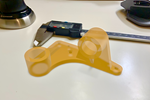Arguably additive manufacturing has always blurred the lines between the physical and digital worlds, but recent overlaps with AR are blurring it even further. Augmented reality is both advancing AM and benefiting from this technology — some examples:
1. AR reduces the impact of prototyping. It might seem odd for a materials company to develop a digital tool meant to motivate less prototyping and thereby reduce its associated waste, but polySpectra is going all-in on an augmented reality utility called Massless.

The bracket in the foreground is a “massless” prototype placed on the table via augmented reality. PolySpectra’s new AR tool allows users to view their STL files in the real world before hitting “print.” Source: polySpectra

I got the chance to “try on” my Fitz Frames glasses before ordering in our episode of The Cool Parts Show featuring the company.
2. AR supports mass customization enabled by 3D printing. Take the idea of a massless prototype a few steps farther and you have the augmented reality experience provided by glasses manufacturer Fitz Frames. The AR is both shopping experience and fitting for the 3D printed frames.
3. AR can be used to improve AM training and workflow. Fraunhofer IAPT has developed training protocols that can coach technicians through tasks such as changing the recoater blade inside a laser powder bed fusion machine with AR pop-ups. Humtown Additive, which 3D prints sand cores and cavities for casting, is also exploring the use of AR to help workers locate and depowder printed items faster.
4. Meanwhile, 3D printing also enables augmented reality devices. Rekkie’s Smart Ski Goggles featured a heads up display to show skiers stats like time and speed, as well as distance and direction to other members in their group. The necessary electronics are held in an enclosure made of 3D printed parts, specifically designed to simplify assembly. (The company recently appeared on Shark Tank.)
The enclosure on the side of Rekkie’s smart ski goggles is made from several Multi Jet Fusion 3D printed parts.
Related Content
-
Sinter-Based Additive Manufacturing Finds a Place Alongside MIM, Press and Sinter at APG
Powder metallurgy company Alpha Precision Group (APG) is applying a particular class of metal 3D printing technology for both rapid iteration in development and flexibility in production.
-
Titanium Golf Club Line Leverages AM to Boost Clubhead Performance
Japanese lifestyle golf brand Designer utilizes Farsoon 3D printing to optimize the design and production of its latest titanium golf club line.
-
Foundry Lab: How Casting in a Day Will Improve the Design of Metal Parts (Includes Video)
The company’s digital casting process uses 3D printing, but the result is a cast part. By providing a casting faster than a foundry, the company says effective prototyping is now possible for cast parts, as well as bridge production.


.jpg;width=70;height=70;mode=crop)













